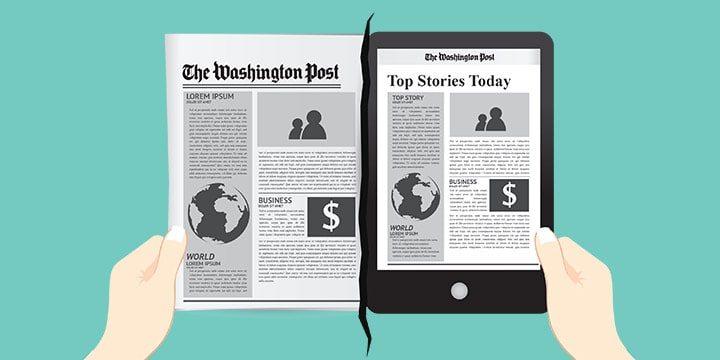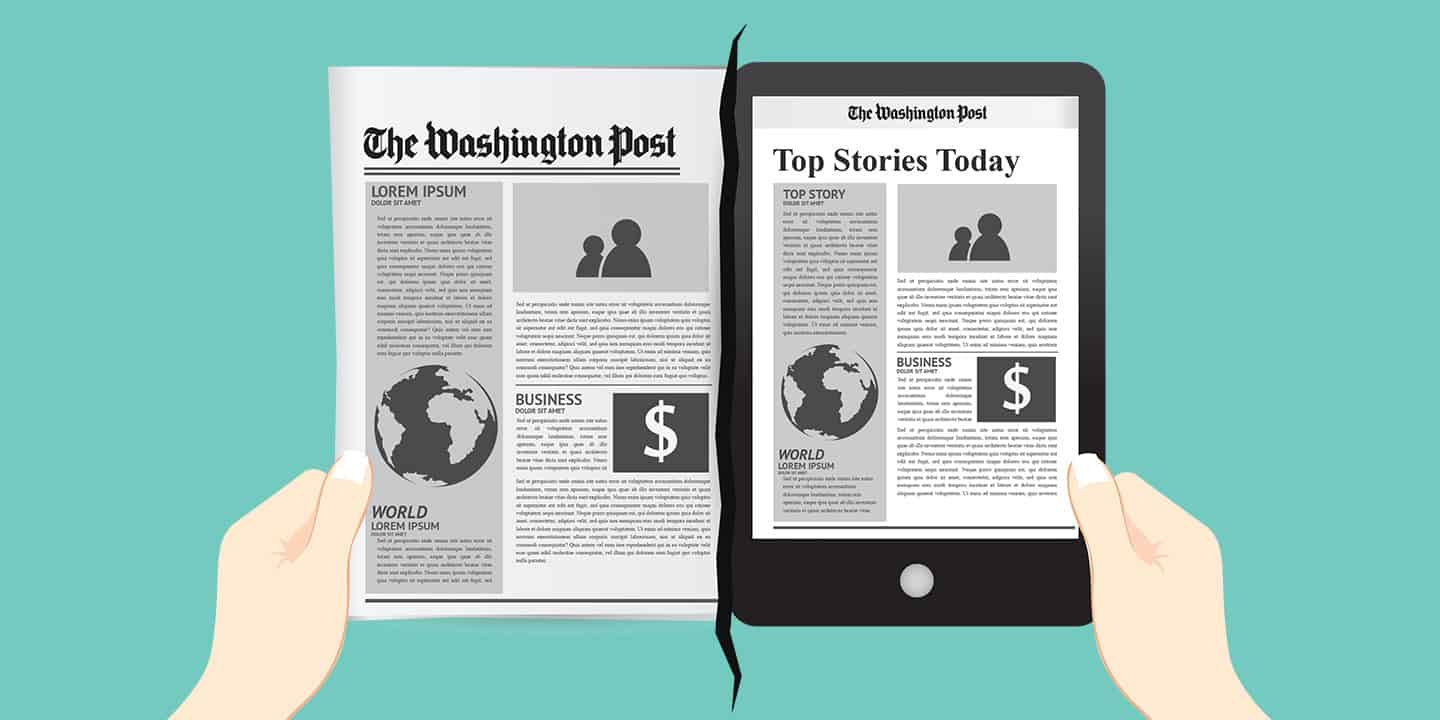
On August 5, 2013, Jeff Bezos bought his hometown paper, The Washington Post, for $250 million USD. While highly regarded, the paper was headed for its seventh consecutive year of declining revenue. Many wondered why he would spend so much for a fading business. One angle is clear: Bezos has a love of the written word. Amazon.com’s beginnings as an online book store, and the Kindle e-reader platform show this. But he’s also a keen businessperson, and recent changes at The Post are bringing another angle into view: Bezos knows that news is still huge business, but only if you think digital first.
Knowing the reader

It’s fair to say that news organizations understand that digital publishing is the future. Printing news on paper is expensive, and print readership — as well as print advertising — has been in steady decline since the early 2000s. But change comes slowly in many an older institution, and it’s often hard to see the fads from the lasting trends when it comes to technology. The irony is, technology provides the greatest tools for gathering and analyzing data.
Knowing what your readers want is the first step in providing it to them. After someone picks up a physical newspaper, how do you tell which articles they enjoyed? On the other hand, in a web or mobile app, users are constantly telling publishers about article and section preference, what sorts of ads they prefer, and even their average reading time. The problem is that few publishers are equipped to listen properly.
With Amazon, Bezos has perfected the art of suggesting what you should buy next. He’d be crazy not to equip The Post with a similar ability to analyze reader preferences. From a user’s perspective, great article suggestions provide a better and more engaging experience. From an advertising perspective, knowing a reader’s preferences means you can show them ads they’re more likely to care about. Well-targeted ads can be extremely profitable.
Experimentation and change

Making changes in an organization as steeped in tradition as The Post is difficult. A careful balance needs to be struck between ensuring content quality and increasing profitability. As it was with Amazon, Bezos’ way forward for The Post is based around experimentation. This means taking risks. Publishers are still figuring out the best way to produce news in the digital age. People in news organizations need to be empowered to try things, some of which may fail.
As much as he’s advocating for change and experimentation, Bezos has admitted that he prefers to read a printed paper. He’s also keenly aware that the future of print isn’t profitable. Shortly after buying The Post, he made this explicit:
“You have to figure out: How can we make the new thing? Because you have to acknowledge that the physical print business is in structural decline. You can’t pretend that that’s not the case. You have to accept it and move forward … The death knell for any enterprise is to glorify the past, no matter how good it was, especially for an institution like The Washington Post, which has such a hallowed past.”
It’s clear Bezos doesn’t think “digital first” means everything about print should be thrown away. In-depth reporting, a coherent editorial voice, and a strong sense of integrity are centuries old traditions which can be lost in the newness of digital publishing. While keeping these traditions is important, simply re-publishing print content for web and mobile isn’t an effective strategy. Publishing digitally brings its own advantages and challenges.
The digital newsroom
Before the iPhone, it made sense for the print side of an organization to lead and have digital follow. A fixed-sized web design could contain print content without many extra considerations, and social media was still finding its legs. Now social users drive vast amounts of traffic to news sites, and it’s impossible to guess a user’s screen size before they arrive. Dealing with this requires changes to the editorial flow.
The New York Times has taken this problem to heart, and created Scoop, a custom content management system (CMS) to solve it. The CMS lets writers and editors work together to provide a great reading experience for all platforms. The CMS is being used for digital content now, but the goal is for print journalists to use it in the near future. Currently journalists write for print and then send their copy to web editors who add applicable multimedia. By 2015 this flow will switch, with all writers deploying digitally and newsprint being just another channel for content.
To tackle similar issues inside of his organization, The Post opened a digital-first think tank named WPNYC. The new office is slated to experiment with new forms of advertising, as well as improving the user experience for all Post properties. It’s also a safe bet that they’ll come up with solutions similar to Scoop for providing additional collaboration between editors and reporters.
Reader choice

News is no longer one-size-fits-all. Some readers want long form in-depth reporting, others are just looking for the headlines. While their profitability remains to be seen, some digital-only apps like Yahoo News Digest and Circa offer amazing experiences crafted specifically for mobile devices. They both capitalize on the context of the reading experience: concise versions of headline stories are provided in an engaging package. With Circa, you can opt in to receive push notifications for a story to learn more as it evolves. Yahoo News Digest provides two daily editions, each with just the top stories of the day packaged for easy reading on the go. In the same way that some of us love the physicality of newsprint, news apps that feel good will attract a generation who see newspapers as antiquated. In other words, news has to adapt to its medium.
The Post already has a suite of apps, but Bezos has an ace in the hole. Later this fall, a specially packaged version of the Washington Post will be available for free on larger Kindle devices, and available via subscription for users on other devices.
Not only will this increase the worldwide readership for his content, but this new tablet version will give users a more magazine-like experience. The written content probably won’t vary wildly from what might hit a printed page, but the presentation and overall feel of an app makes a huge difference. The point is, there doesn’t need to be just one app or site for delivering your content.
The democratization of news

The internet has given more people access to report the news, and traditional media has often been slow to listen. Events in Ferguson, Missouri this August were a reminder of this. Local people reported the situation on Twitter for at least 48 hours before mainstream press began examining what was happening.
Services like Medium and Reddit are also playing a part. Founded in 2012 by the people behind Twitter, Medium is increasingly competing with news magazines. While it employs some writers, much of its promoted content comes from unpaid users. The biggest difference between Medium and something like Google’s Blogger or WordPress.com is in how it promotes content inside of its network. Similarly, Reddit allows community members to submit stories, and democratically decide which content should be shown on the front page.
The Post has picked up on this trend, and has partnered with the New York Times and Mozilla (the organization behind the FireFox web browser) to create a new community platform. More than just an upgrade on the comments section, the goal is to allow easier engagement with readers, and to allow the best of their conversations to appear as news. Once in place, this system is expected to shift the balance further toward engagement, and helps show that not all third party news needs to come from AP or Reuters.
The Bottom Line
Bezos’ bet with The Post is that news can still be huge business, but it has to change with the times. As the paper refocuses on digital publishing, we’re seeing that a combination of experimentation, analytics, and reader-focused thinking is key to finding a profitable way forward. It’s true that Bezos has an edge in terms of infrastructure and funding, but these core ideas can be implemented on any scale and still have real impact.
It would be shocking if news organizations haven’t already started thinking along these lines, but thinking isn’t doing. With advertisers increasingly moving dollars to mobile ads, and more reading being done on mobile devices, there’s never been a better time to adopt a digital first publishing strategy. There exists a real opportunity to leapfrog those publications still making business decisions in column inches. We’re betting that’s why Bezos bought The Post, and we can’t wait to see what’s next.
Are you a publisher looking to enhance your digital strategy? Last year, MindSea partnered with The Chronicle Herald to redesign and redevelop their iOS app. The app went on to be recognized by Apple in their Best of 2013 category, and was awarded second place in the International News Media Association Awards. We also developed the Android and iOS apps for the Postmedia Network. If we’ve piqued your interest, you can get started now with our App Design Guide or get full details on our approach and pricing with a quick email to hello@mindsea.com.



